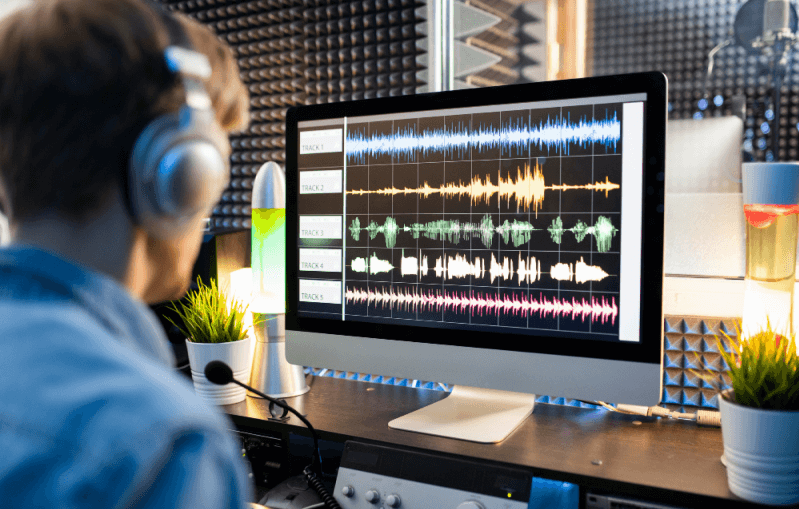Why specialized audio visual charlotte nc is necessary for memorable events
Understanding the Incorporation of Audio Visual Innovation in Today's Educational Environments
The combination of audio-visual innovation in educational settings has actually changed the training and finding out procedure. Educators now have access to tools that satisfy various learning designs, improving student engagement and collaboration. Nonetheless, the incorporation of these innovations provides both chances and challenges. Comprehending how to properly implement these devices is crucial. What approaches can educators employ to maximize the benefits of audio-visual modern technology in their classrooms?
The Evolution of Audio-Visual Technology in Education And Learning
As educational demands advanced over the decades, audio-visual modern technology went through substantial makeovers that improved the understanding atmosphere. At first, tools such as movie projectors and slide shows were the primary means of integrating aesthetic aspects right into classrooms. These early innovations provided instructors with the ability to existing details dynamically, yet they were restricted in accessibility and interactivity.
With the arrival of video cassette recorders in the 1970s, class began to include recorded lessons, broadening the extent of academic sources. The intro of personal computers in the 1980s additional changed this landscape, permitting for the creation of multimedia presentations and interactive understanding experiences.
The surge of the net in the 1990s marked a zero hour, enabling real-time accessibility to a wide range of audio-visual materials. Today, digital devices such as interactive whiteboards and on the internet understanding systems remain to improve the instructional experience, fostering interaction and collaboration among learners.
Benefits of Audio-Visual Tools for Diverse Learning Styles
Audio-visual devices play an important duty in dealing with varied learning designs by boosting visual discovering and enhancing acoustic involvement. By incorporating photos, video clips, and noise, these modern technologies develop an even more comprehensive academic atmosphere. This multifaceted method enables instructors to resolve the varied choices and requirements of students effectively.
Enhancing Visual Understanding
Interaction in the knowing process is substantially improved through using audio-visual devices, providing to various learning styles. These tools, such as video clips, infographics, and interactive discussions, provide visual stimulations that aid comprehension and retention. Aesthetic learners, specifically, gain from the incorporation of photos and animations, which can streamline complicated ideas and boost understanding. In addition, audio-visual sources can illustrate real-world applications, making finding out more appropriate and appealing. By incorporating color, motion, and audio, instructors can develop a vibrant knowing setting that catches trainees' attention and cultivates much deeper cognitive connections. Eventually, the critical use of audio-visual technology not only supports aesthetic understanding yet also enriches the general academic experience for varied students.
Improving Auditory Involvement
A significant advantage of integrating audio-visual tools in education is their capacity to boost acoustic engagement among trainees. These devices, which incorporate multimedia presentations, podcasts, and interactive audio elements, satisfy different finding out designs, specifically benefiting auditory learners (audio visual charlotte nc). By integrating noise and narrative, instructors can develop immersive experiences that record students' focus and enhance comprehension. This engagement is crucial, as it cultivates a much deeper understanding of the product and advertises retention. Furthermore, audio-visual tools can help with collaborative learning settings, urging pupils to take part in conversations and share their insights. Ultimately, the unification of audio-visual modern technology not just supports auditory interaction yet additionally enhances the general educational experience, making finding out a lot more dynamic and effective for all pupils
Enhancing Interaction Through Interactive Learning

Furthermore, gamification components, such as quizzes and simulations, can boost motivation and retention, making finding out more satisfying and effective. These techniques not just promote cognitive involvement but additionally deal with varied learning designs, guaranteeing that all students can take part meaningfully. As a result, interactive discovering environments cultivate a sense of area and belonging, eventually leading to enhanced academic end results. With the assimilation of audio visual technology, instructors can change traditional classrooms into lively spaces where pupils flourish and proactively form their educational journeys.
Connecting Concept and Exercise With Multimedia Resources
Multimedia resources offer as an important web link in between academic concepts and useful application in instructional setups. By improving engagement, facilitating collaborative learning experiences, and supporting diverse learning styles, these devices develop an extra comprehensive and vibrant understanding setting - audio visual charlotte nc. This approach not only fosters deeper understanding however likewise prepares trainees for real-world obstacles

Enhancing Involvement With Multimedia
Interaction in academic settings greatly increases when instructors include multimedia sources into their teaching strategies. Making use of videos, podcasts, and interactive presentations enhances the discovering experience, allowing trainees to connect with the material on numerous levels. Multimedia resources deal with different learning designs, offering aesthetic, auditory, and kinesthetic stimulations that can hold trainees' focus better than typical lecture techniques. Additionally, these sources can streamline complicated principles, making them a lot more accessible and remarkable. By integrating multimedia, teachers can create a dynamic class environment that cultivates curiosity and inspires learners. Eventually, the strategic use of audio-visual modern site technology serves to link the gap in between academic understanding and sensible application, enriching the academic experience for both instructors and trainees.
Promoting Collaborative Discovering Experiences
Various researches suggest that joint learning experiences markedly boost student results when incorporated with multimedia resources. Multimedia devices promote interaction among pupils, allowing them to participate in analytic and crucial believing jointly. By utilizing video conferencing, collaborative systems, and interactive discussions, teachers develop environments for synergy and shared knowing. These technologies make it possible for pupils to communicate their ideas effectively and receive immediate feedback, fostering a deeper understanding of the subject matter. Furthermore, multimedia resources can provide complicated ideas in even more absorbable styles, promoting discussion and partnership. Therefore, the combination of joint knowing and audio-visual innovation not just improves the educational experience but additionally prepares pupils for real-world synergy characteristics, stressing the relevance of participation and cumulative understanding building and construction.
Sustaining Diverse Discovering Styles
While standard mentor methods typically cater to a web link limited variety of learning choices, the assimilation of audio-visual modern technology supplies a more comprehensive technique to education. By employing multimedia sources such as videos, interactive simulations, and digital presentations, instructors can attend to different discovering styles, consisting of visual, auditory, and kinesthetic. This flexibility enables set apart direction, allowing students to involve with material in manner ins which resonate with their specific choices. Additionally, audio-visual devices can facilitate much deeper understanding by supplying multiple representations of intricate ideas. Therefore, students that may battle with standard techniques can find different paths to success, fostering an extra fair knowing environment that supports scholastic achievement for all learners.
Challenges in Executing Audio-Visual Technology
Audio-visual innovation holds great pledge for boosting educational experiences, its execution typically runs into significant difficulties. One key issue is the monetary problem related to getting and keeping such equipment, which can strain budgets, particularly in underfunded organizations. In addition, poor training for instructors can prevent reliable integration, leaving them ill-prepared to utilize the technology fully. Technical issues, such as software malfunctions and compatibility problems, may also interrupt lessons and irritate both instructors and pupils. Moreover, varying levels of student access to innovation outside the classroom can produce variations in discovering my explanation possibilities. The possibility for over-reliance on technology may take away from important teaching methods, inevitably restricting the educational experience. Addressing these obstacles needs a complete method, including ample financing, professional growth, and equitable accessibility to resources, to guarantee that audio-visual modern technology can be leveraged efficiently in today's instructional settings.
Best Practices for Integrating Innovation in the Classroom

Furthermore, promoting an interactive atmosphere via joint devices urges pupil involvement and participation. Utilizing varied audio-visual resources accommodates various learning styles, accommodating visual, acoustic, and kinesthetic students. Routinely assessing the effect of innovation on student knowing assists teachers fine-tune their methods and adapt to changing needs. Including trainees in the selection of technology advertises possession and inspiration. By sticking to these finest methods, educators can create a vibrant class atmosphere that effectively incorporates innovation and improves the educational experience for all pupils.
The Future of Audio-Visual Innovation in Education
As classrooms significantly accept technology, the landscape of audio-visual devices in education proceeds to progress (audio visual charlotte nc). Future developments are anticipated to concentrate on greater interactivity and customization, enabling educators to customize learning experiences to individual pupil demands. Developments such as increased truth (AR) and virtual fact (VR) will likely give immersive knowing settings, improving pupil interaction and understanding
Fabricated intelligence (AI) is poised to play a substantial role in audio-visual innovation by supplying real-time comments and flexible learning pathways. This combination might help instructors determine and resolve trainee obstacles better. Cloud-based platforms will promote much easier accessibility to resources and partnership amongst students and instructors, despite location.
In addition to these technical breakthroughs, professional growth for teachers will certainly be essential, guaranteeing they are equipped to utilize these tools successfully. On the whole, the future of audio-visual modern technology in education and learning promises to create more dynamic, inclusive, and impactful knowing experiences.
Often Asked Inquiries
Just How Can Teachers Choose the Right Audio-Visual Tools for Their Classrooms?
Selecting suitable audio-visual devices calls for educators to evaluate their instructional objectives, consider student requirements, review available modern technology, and seek recommendations from peers or professionals, making certain devices effectively improve knowing and engagement within their specific class setting.
What Budget Considerations Are There for Executing Audio-Visual Innovation?
Budget plan factors to consider for applying audio-visual innovation include first purchase costs, upkeep costs, training for staff, and possible software program licensing charges. Additionally, lasting financial investment in updates and replacements need to additionally be factored right into financial preparation.
Are There Specific Training Resources for Educators on Audio-Visual Tools?
Many organizations offer training sources for educators on audio-visual tools, consisting of on the internet programs, workshops, and educational guides. These resources intend to improve instructors' abilities and confidence in properly integrating technology into their training methods.
Just how Do We Determine the Effectiveness of Audio-Visual Innovation in Knowing?
Gauging the effectiveness of audio-visual modern technology in learning includes assessing pupil interaction, understanding, retention rates, and general scholastic efficiency. Studies, evaluations, and observational researches can supply important insights into its effect on academic outcomes.
What Prevail False Impressions About Audio-Visual Innovation in Education And Learning?
Usual misunderstandings regarding audio-visual modern technology in education and learning include the belief that it ensures involvement and finding out outcomes, as well as the assumption that all trainees profit just as, forgeting individual learning preferences and demands.